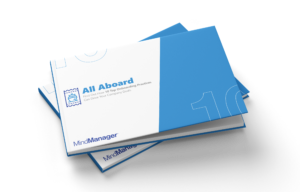Last week, we talked about why employee onboarding is important to achieving you company goals. Specifically, the benefits of employee onboarding and the different parts of your business that it helps to elevate. This week, we’d like to share 10 onboarding best practices that will help your company achieve these benefits.
Onboarding best practices
Here are the top 10 onboarding best practices that you should adopt at your company.
1. Help your company leaders get with the program
If your entire company understands and embraces the importance of employee onboarding from the top floor down, you’ll be more likely to get the time and resources you need to set up and run an effective program. Use some of the stats above to help persuade company leaders of the benefits of investing in your new employee assets.
2. Make it official
Onboarding programs work best if they’re developed as a formal company program, complete with documented step-by-step processes and all the required materials and resources in place.
Download our free eBook to access a pre-made onboarding map template to help you get started.
3. Ensure your hire is well versed in the four Ps
The four Ps—places, projects, processes, and partners (a.k.a. team mates)—form the pillars of knowledge new hires need to know. Ensure your onboarding map includes instruction on where the employee needs to go, the projects they’ll be working on,the company processes they’ll follow, and who they’ll be working with.
4. Start the onboarding process early with a care package
Your new hire is bound to be nervous, but the first day will be less stressful if you send them a care package a week before their start date.
Items in your care package could include:
- personal welcome letter
- first-day agenda
- benefits and perks
- weekly schedule of all team meeetings
- projects they’ll be working on
- names and photos of team mates
- contact lists
- map of your location’s vicinity (highlight parks, coffee shops and lunch spots, parking and public transportation routes)
- map of your office floor (including washrooms, kitchen, safety exists, and where their desk is)
5. Introduce your new hire to your team before the start date
Talk up the new employee to your team. Tell them about the new hire’s achievements, strengths, experience, and how their work will help the entire team achieve their goals. (Be careful not to go overboard though, lest it plants the seeds of professional jealousy.) Assign a trusted mentor or buddy to the new hire that can answer questions and show them around when needed.
6. Be prepared
Make a good first-day impression on your new employee by ensuring everything they need at their desk is up and running. Contact your IT department well in advance to ensure laptops, software, email and phones are fully installed, and have someone on hand to walk the employee through their use. Make the workspace welcoming by including a fun coffee mug or some company-branded gifts. Include things they’ll need to refer to, like the employee handbook and maps.
7. Add the new hire to email contact lists, meeting invites and company communications
This may seem obvious, but it’s surprising how often this small step is overlooked—leaving the new hire to come back from the washroom to find everyone is gone to a meeting they knew nothing about. Add them to the contact list the day before they start.
8. Let’s do brunch or lunch
Chances are your new recruit will be whisked away by HR after they arrive, to fill out paperwork and set up any training. Depending on how long this process is, you may want to schedule a team brunch or lunch to allow everyone to get to know the new employee. Have the assigned mentor sit beside the new hire and help initiate conversations amongst the group.
Remember that effective onboarding takes up to a full year
If you try to cram onboarding into the first day or even the first month, you’ll fail. In fact, information overload can mar the employee’s impression of the company. Instead, plan to check in with the new recruit every day the first week to see how things are going, and then meet weekly and eventually monthly to continue the onboarding process. Many best-practice companies have half-day meetings with new hires at the 30, 60, and 90-day marks, in which the employee provides a presentation of their learnings, progress and questions, as well as any training requirements they need.
10. Times change, so should your onboarding program
Review your onboarding program at least once a year, and re-map new best practices into your system. Stay abreast of changing trends and demographics as well. Generation Z, for example, desires more personal interaction with colleagues and leaders, which may require some changes in your onboarding of these new hires.
Put these onboarding best practices into action
 Visualization software, like MindManager, helps you to establish a repeatable process that will not only save you, as team leader, a great deal of time, but will also ensure that each new hire to your team experiences a consistently high-quality onboarding experience.
Visualization software, like MindManager, helps you to establish a repeatable process that will not only save you, as team leader, a great deal of time, but will also ensure that each new hire to your team experiences a consistently high-quality onboarding experience.
If you’re ready to start using MindManager to plan your onboarding program, then we recommend downloading our free eBook. In it, you’ll find ready-to-use onboarding templates to help kick start your planning process.
Try MindManager for free
Or, if you haven’t gotten your hands on MindManager yet, and are curious about how it can help with your onboarding program, you may be interested in a free, 30-day trial.

